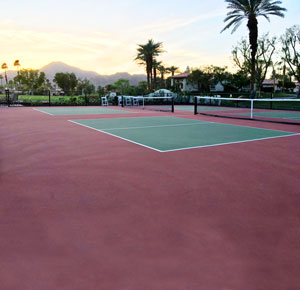The statistics speak for themselves: Pickleball is the fastest-growing sport in America. As of 2023, it’s estimated that more than 48 to 50 million people were playing pickleball, according to research from the Association of Pickleball Professionals, and there are many local facilities supporting the trend with courts dedicated to the growing sport.
For recreation managers, this is certainly no secret. If you haven’t already done so, you are probably considering building a new pickleball court or converting a seldom-used existing surface. Consider that four pickleball courts can be retrofitted onto an existing tennis court—if tennis traffic has been lacking lately, retrofitting for pickleball use can be an effective way to maximize utilization of your infrastructure while satisfying demand within your facility.

But gone are the days of throwing down some tape on a basketball court or other such half-measures. Players aged 55 and up are the largest age bracket of pickleball players, while the average age is 38 years. The most avid players typically have time on their hands and money to spend, and they are looking for dedicated courts that provide an ideal playing experience. Facility managers have the opportunity to capitalize.
When undertaking the development of pickleball courts, there are a number of factors to consider. One of the most important is your choice of surface. Durability, performance characteristics and color options are all desirable attributes that can elevate the pickleball experience at your park or facility—and your users will be happier for it.
The Value of Shock Absorption
While hard court surfaces will do the job for pickleball courts, one thing managers should consider is whether to upgrade to a cushioned or shock-absorbing system.
Selecting a high-quality cushioned system that delivers the proper levels of shock absorption is important. Cushioned systems incorporate acrylic resins and rubber granules that are designed to absorb impact and redistribute pressure, enabling a desirable feel for the player without compromising durability. Users won’t notice much of a difference during gameplay, but a more comfortable playing surface can help alleviate some of the next-day soreness that can occur after playing on a hard court. Shock-absorbing systems can be applied to a variety of surfaces, but they’re especially beneficial for pickleball—a sport that prides itself on its approachability and an “anyone can play” attitude.
Importantly, too soft a surface can impact the bounce of the ball, leading to adverse playing conditions. Excessive cushioning can contribute to the greater likelihood a player may experience an injury while playing such as a rolled ankle. To avoid these types of problems if opting for a cushioned surface, be sure to work with a reputable supplier.
Reflective Surface Options

If your courts are outside, another feature to look for when selecting a pickleball surface is its solar reflective index (SRI), which measures the reflectivity of a surface. Reflective surfaces are becoming more popular in a range of applications, including industrial rooftops and parking lots, in order to mitigate heat sinks and keep local climates a touch cooler and more comfortable.
It’s also a metric to consider for sports surfaces. A surface that reflects a certain amount of sunlight can help keep on-court temperatures more desirable when the sun is shining. But like with cushioning, it’s important to strike the proper balance. Importantly, a reflective surface needs to meet the right standards so that it does not become too bright, affecting visibility on the court.
Much of this has to do with color coordination. While traditional tennis courts have historically tended to be darker greens and terracotta reds, customization reigns supreme with pickleball enthusiasts. Grays and blues are popular as new courts proliferate—but when exploring reflective technology, it’s important to strike the right balance. An experienced surface supplier should be able to assist you in arriving at the right option.
Next Steps
Recreation managers have a ripe opportunity to supply their community with high-performance, in-demand pickleball courts by selecting a high-performance surface solution. In addition to value-adding characteristics like shock absorption and reflectivity, your choice of surface technology should also exhibit the qualities of any high-quality sports surface: proper traction, low maintenance, and long-term durability. Working with the right supplier is crucial in helping you select and specify the optimal surface solution for your court. RM
ABOUT THE AUTHOR
Tom Magner is director of product management for California Sports Surfaces, an ICP company. Tom has almost three decades of experience bringing high-performance sports surfaces to life in some of the most demanding and critical applications in the world, including multiple Olympics tournaments and other high-profile competitions. To learn
more, visit www.californiasportssurfaces.com.



